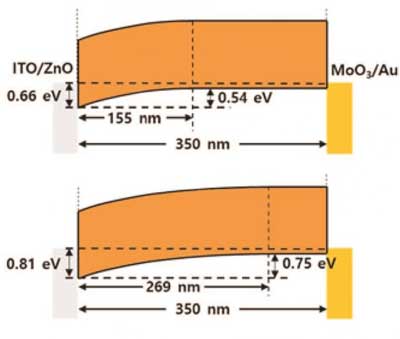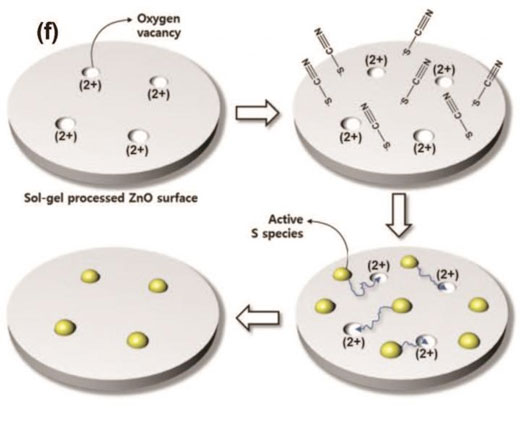| Jul 09, 2018 | |
Realization of color filter-free image sensors(Nanowerk News) A South Korean research team has developed a new-concept image sensor that captures vivid colors without color filters. The Korea Research Foundation announced that Professor Dae Sung Chung (Daegu Gyeongbuk Institute of Science and Technology, DGIST)'s research team has developed an organic image sensor with high color selection using a bonding technique between organic semiconductors and transparent electrodes (Advanced Functional Materials, "Defect Restoration of Low-Temperature Sol-Gel-Derived ZnO via Sulfur Doping for Advancing Polymeric Schottky Photodiodes"). |
|
 |
|
| Scheme of Schottky contact between electrodes and semiconducting polymer. Upper panel is for the case of pristine ZnO and lower panel is for the case of S-doped ZnO. Estimated depletion width and built-in potential of each sample are denoted in the figure. (Image: DGIST) | |
| The image sensor is a key recording element in cameras, CCTV, and self-driving cars. Most image sensors that have been commercialized thus far are silicon based, and color filters are essential to accurately identify the color of light. However, color filters are expensive and have the fatal drawback if increasing image sensor thickness. | |
| The research team developed thin image sensors based on organic semiconductors that can compensate for the shortcomings of silicon image sensors. In particular, their research results have been garnering much attention because they enable images to be implemented clearly without using color filters by increasing the color selection of organic semiconductors. | |
 |
|
| Schematic mechanism of S-doping of sol-gel processed ZnO film. Spin-coated thiocyanate ion is converted to active S species by heat treatment and migrated to oxygen vacancies by electrostatic force. Finally, tetrabutylammonium ion and residual thiocyanate ion are washed with ethanol. (Image: DGIST) | |
| The research team developed a method to fill chemical defects in the transparent electrode surface made of zinc oxide with sulfur atoms. Through this, Schottky junction* property between organic semiconductor and transparent electrode have been maximized, and thus increased each R/G/B color selection options. | |
| In addition, as the surface defects of transparent electrodes are dramatically reduced and the quality of thin films is excellent, it can greatly improve reproduction, which has been a chronic problem of organic semiconductors. | |
| Professor Chung explained the significance of the study by saying, "We have developed high-performance color filter-free organic image sensors using an ideal Schottky junction between organic semiconductors and transparent electrodes. As well as color filter-free image sensors, it is expected to be applicable to many industrial applications that require various forms of bonding, such as solar cells, thin film transistors, and gas sensors." |
| Source: Daegu Gyeongbuk Institute of Science and Technology | |
|
Subscribe to a free copy of one of our daily Nanowerk Newsletter Email Digests with a compilation of all of the day's news. |
